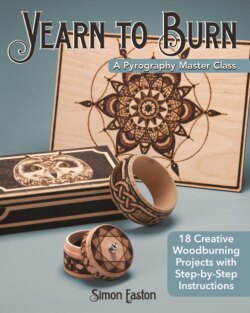Читать книгу Yearn to Burn: A Pyrography Master Class - Simon Easton - Страница 17
На сайте Литреса книга снята с продажи.
Shading Techniques
ОглавлениеShading helps to create a sensation of form, depth, and texture in your pyrography designs. As with basic mark making, it is another technique that requires practice to become adept and confident. Broader shading nibs are extremely useful for creating areas of tone without looking scratchy or uneven. I recommend starting any shading at the lighter end of the tonal spectrum; if you shade too darkly at the beginning of a design, it can be very hard to amend the error. Starting with lighter tones and gradually building up to the darker shades through careful application or “layers” reduces the prospect of ending up with something that you cannot correct. Start with a lower temperature and don’t press too hard on the surface. Try to keep the motion of your nib across the surface as smooth as possible, gliding lightly to build up the tone gradually.
There is a range of shading effects that you can use in place of traditional “smooth” shading. Stippling (the use of dots) and cross-hatching (the use of lines) are equally successful in bringing different tonal values into your work. I recommend practicing these techniques on spare pieces of wood, experimenting with the nib that you select, the way that you hold or apply it to the surface, the temperature setting, and the pressure and duration of the contact. These two techniques enable you to change the shading effect that you are creating through changing the size, shape, frequency, and intensity of the marks. Lighter tones are created by spreading the dots or lines further apart, using a lighter touch of the nib onto the surface, or reducing the temperature of the machine itself. The opposite approach can be used to create darker and more intense areas of contrasting tone. Practice a range of methods in order to broaden your pyrography “arsenal” of techniques.
